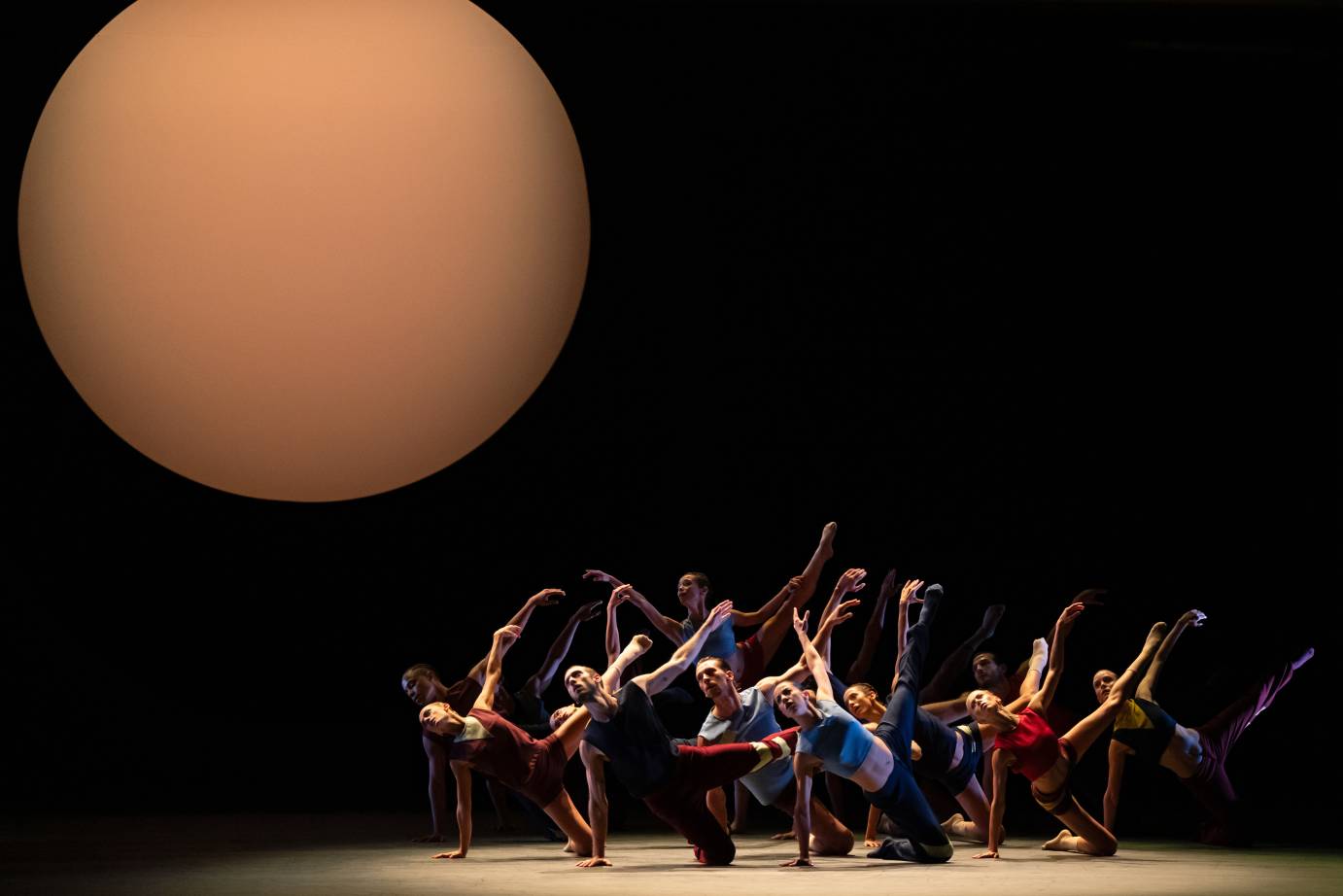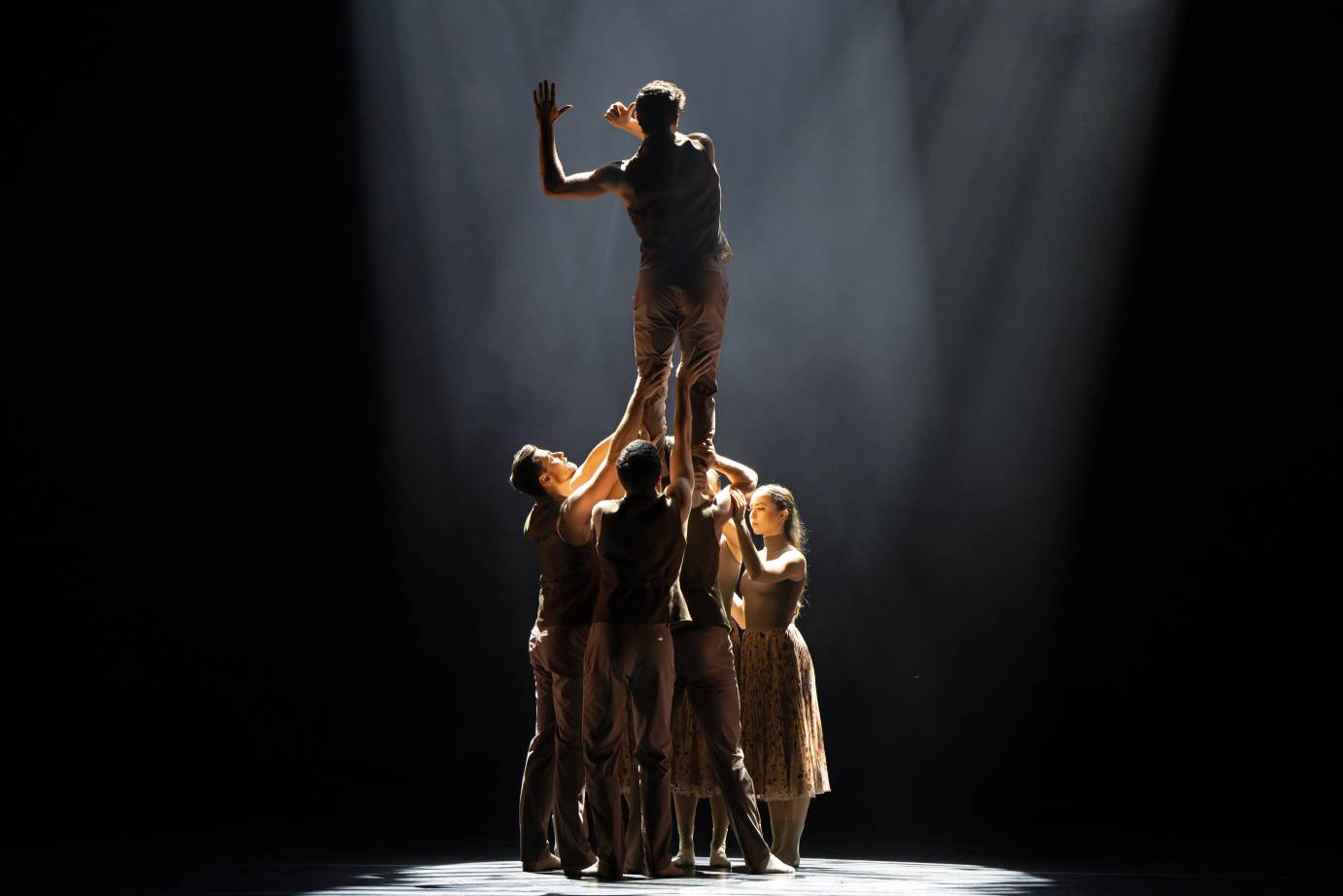IMPRESSIONS: New York City Center's Fall For Dance 2024 (Programs 4 and 5)

Dates: Thursday, September 26 and Sunday, September 29, 2024
Program 4 (click for full credits): Canada's Royal Winnipeg Ballet, A.I.M by Kyle Abraham, and CCN/Aterballetto
Program 5 (click for full credits): Dutch National Ballet, Cassandra Trenary, and Gandini Juggling
George Gershwin’s Rhapsody in Blue is one of the most instantly recognizable American scores. One hundred years after its premiere, the Italian company CCN/Aterballetto takes it on and presents a refreshingly insubordinate ballet for 14 wonderful dancers. The company performed the piece, choreographed by Iratxe Ansa and Igor Bacovich on September 26, as part of the Fall for Dance festival at New York City Center.
A single, giant disc that occasionally changes color hangs suspended at the back of the stage. At times, it feels as if a supermoon smiles at the follies of humankind. Stories unfold in ever-changing groupings. A leg swings at the head of a dancer who ducks to avoid being hit; and another dancer catches the rotating limb before it strikes his chest. When he tries to push the leg away from him, it won’t move at first, and it takes another more serious effort to send it back in the direction it came from. Can you tell I am hooked? It’s physical humor at its finest.

Energy whips across the stage space when performers fall to the ground one after another, seconds apart, only to spring up again and reconfigure in a completely different pattern. A string of physical bagatelles creates a world of farcical wonderment. Colorful costumes created at the crossroads of beach, gym, and circus attire complement the jolly athletics and the fine dancing. I have never thought of Rhapsody in Blue as a Southern European commedia, but choreographers Ansa and Bacovich have me fully convinced that Gershwin must have written this masterpiece with Aterballetto in mind. Costume and scenic design by Fabio Cherstich and lighting by Eric Soyer create symbiotic worlds of fascination in which the dancers live large and dance happily ever after.

Even if this closing number by the Italians steals the show, the other offerings on Program 4 make for a satisfying whole. Watching šεgatәm, performed by the Royal Winnipeg Ballet, I don’t catch on to the tribal theme of Tla’amin Nation Elders and the story of a leader facing burn out, who must learn the hard way to lean on his community. I see a ballet soloist held aloft by a group, who then dances for a long while by himself before he gets to dance with the others, and is momentarily held aloft again before the piece eventually ends. This piece is balletic and handsomely constructed, and it makes me wonder if the tribal flavor got lost on the long journey from the Canadian prairie. But then I read the program again and realize that šεgatәm is a world premiere, choreographed by Cameron sinkʷǝ Fraser-Monroe. If anyone ever complains again about putting an umlaut over the u in my last name, I will send them to Canada.

Jamaal Bowman and Donovan Reed, the two beautiful dancers in Kyle Abraham’s MotorRover, are clad in brown-yellow and grey-blue patterned, loose-fitting, comfortable outfits that allow for ample movement. Yet the dancers exhibit intimacy, and make small gestures count as much as any sweeping motion. I wish for more spatial exploration to juxtapose the quiet closeness, which touches me nevertheless. Costume design by Reid Bartelme and Harriet Jung and lighting design by Dan Scully add to the experience.

One thing I have enjoyed in many editions of the Fall for Dance festival has been the incorporation of folkloric dances and dances from non-Western traditions.
This year’s presentation did away completely with the traditional element, and I longed for inclusion. The earnestness of many a contemporary dancemaker does not necessarily brighten one’s day; and the festival’s attempt at lightness was not always successful.
On Program 5, September 29, Gandini Juggling presented excerpts from Smashed2 by Sean Gandini and Kati Ylä-Hokkala. The piece is an overlong mess with lots of oranges and nine dancers who are forced to juggle in all kinds of distressing situations that are meant to be funny but feel like torture.
The Dutch National Ballet shows off its lovely dancers in Hans van Manen’s Four Schumann Pieces that he originally created for the Royal Ballet in 1975. Schumann’s String Quartet Opus 41, No. 3 gives the dancers ample sound to feel joyous. The dancers run with abandon, turn effortlessly, and partner each other with skill, but what should be the icing on the cake is bravura dancing for its male principal. In the festival’s closing Sunday matinee, however, Constantine Allen unfortunately does not deliver fireworks. He is a fine dancer, but the brio necessary for the part is missing.

A slightly injured Sara Mearns did not feel up to taking on Molissa Fenley’s fantastic solo State of Darkness, but opted to perform Christopher Wheeldon’s This Bitter Earth with partner Tyler Angle, which I just reviewed in my recent article on the New York City Ballet’s “Eclectic” program.

Even if the inclusion of an extra piece makes the show feel long, the performance of Fenley’s tour de force by American Ballet Theatre principal Cassandra Trenary is worth the price of admission. Fenley created the work on herself in 1988, and her thrilling rawness and physical perseverance get a makeover in Trenary’s gorgeous lines and an insouciance that I find strangely becoming. It is freeing to see this work, recently performed by a string of fine solo dancers at The Joyce, with space around it on the larger City Center stage. Fenley’s choreography appears painterly and stretches the canvas. One cannot help but follow Trenary’s every step on her transfixing journey, as she pushes the boundaries of what a single dancer can do in terms of energy and endurance. Instead of bothering with prettiness, Fenley makes Trenary work hard, even if it seems effortless at times. In return, dancer and audience earn the reward of beauty, which is surely something to treasure and to take home from a live performance.












